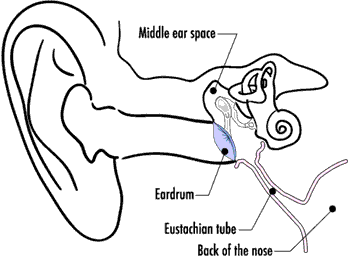Ear Tubes and Ear Tube Surgery

Does my child need ear tube surgery?
Ear tubes are recommended for children who either get lots of ear infections or have fluid behind the eardrum that doesn’t go away. Both of these problems are most common between the ages of 6 months and 3 years, although older children sometimes have these problems too. During ear tube surgery, a surgeon places ear tubes into the child’s eardrum, allowing the fluid to drain.
How do ear tubes work?
During an ear infection, fluid builds up behind the eardrum in a place called the middle ear space. Normally, when the ear infection has run its course the fluid drains out of the middle ear into the back of the nose through the body’s natural drainage tube called the Eustachian tube (yoo-STAY-shun).

Sometimes this fluid doesn’t go away because the Eustachian tube remains swollen and can’t open. Fluid trapped behind the eardrum causes a hearing loss because it prevents the eardrum from vibrating normally.
Ear tubes are small plastic or metal tubes that are surgically inserted into the eardrum (also called the tympanic membrane).
Ear tubes also allow air to get into the middle ear. Just like the big bubbles in the water tank on top of a water cooler, air needs to get into the middle ear in order for the fluid to drain out. Over time this “ventilation” helps to decrease swelling in the Eustachian tube and allows it to function normally again. This is why ear tubes are sometimes called ventilation tubes or pressure equalization tubes (PE tubes for short).

What is ear tube surgery like?
Ear tubes are put in by an ears, nose, and throat surgeon. Using a microscope, a small incision is made in the eardrum. The tube is then placed through this hole.
Since the tubes are very small, this is a delicate operation. Because children cannot hold still for this procedure it is performed in the operating room under general anesthesia. In this day and age, general anesthesia is very safe and your child will be carefully monitored during the procedure. You will have a chance to talk with the anesthesiologist on the day of surgery to discuss any questions you may have about the anesthesia.
What can I expect for ear tube surgery recovery?
The procedure itself usually takes no more than 10 or 15 minutes. Your child will wake up in the recovery room after surgery. This may take 30 to 45 minutes. When your child is awake, he or she will be taken to the discharge area to complete the recovery. You can be with your child once he or she has been transferred to the discharge area.
Your child may have a low-grade fever (99° to 100°F) for a day or two after ear tube surgery.
There may be a thin, watery discharge from either ear (pink, clear, yellow, or even bloody in color) for 2 or 3 days. Your doctor may give you some ear drops to use after surgery to help control the ear tube drainage.
Your child may experience some pain after ear tube surgery in the form of an earache. This is caused by pressure changes in the ear and/or hearing louder sounds than he or she is used to. You can treat this short term discomfort with Tylenol® (acetaminophen) or Children’s Motrin® (ibuprofen). You will get a Discharge Instructions sheet before you go home which will indicate how much medicine to give and how often.
Overall, ear tube surgery recovery time is relatively brief. You can expect your child to be back to his or her regular diet and activities within 24 hours after surgery.
